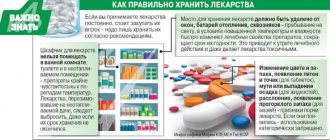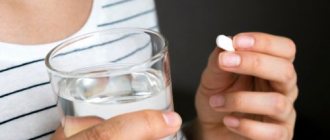Acetylcysteine
A mucolytic agent that thins sputum, increases its volume, and facilitates the separation of sputum. The action is associated with the ability of free sulfhydryl groups of acetylcysteine to break intra- and intermolecular disulfide bonds of acidic mucopolysaccharides of sputum, which leads to depolymerization of mucoproteins and a decrease in sputum viscosity.
In addition, it reduces induced hyperplasia of mucoid cells, enhances the production of surfactants by stimulating type II pneumocytes, and stimulates mucociliary activity, which leads to improved mucociliary clearance.
Remains active against purulent sputum, mucopurulent and mucous sputum.
Increases the secretion of less viscous sialomucins by goblet cells, reduces the adhesion of bacteria on the epithelial cells of the bronchial mucosa.
Stimulates mucous cells of the bronchi, the secretion of which is lysed by fibrin. It has a similar effect on the secretions formed during inflammatory diseases of the ENT organs.
It has an antioxidant effect due to the presence of an SH group that can neutralize electrophilic oxidative toxins.
Acetylcysteine easily penetrates into the cell and is deacetylated to L-cysteine, from which intracellular glutathione is synthesized. Glutathione is a highly reactive tripeptide, a powerful antioxidant, cytoprotector that traps endogenous and exogenous free radicals and toxins. Acetylcysteine prevents exhaustion and helps increase the synthesis of intracellular glutathione, which is involved in the redox processes of cells, thus promoting the detoxification of harmful substances. This explains the effect of acetylcysteine as an antidote for paracetamol poisoning. Paracetamol exerts its cytotoxic effect through the progressive depletion of glutathione. The main role of acetylcysteine is to maintain proper levels of glutathione concentration, thereby providing protection to cells.
Protects alpha1-antitrypsin (elastase inhibitor) from the inactivating effects of the oxidizing agent HOCl produced by myeloperoxidase of active phagocytes. It also has an anti-inflammatory effect (by suppressing the formation of free radicals and reactive oxygen-containing substances responsible for the development of inflammation in the lung tissue).
Acetylcysteine Canon (100mg, 200mg, 600mg)
Pharmacodynamics
Acetylcysteine is a mucolytic expectorant used to thin mucus in diseases of the respiratory system. Acetylcysteine is a derivative of the natural amino acid cysteine (N-acetyl-L-cysteine). It has a pronounced mucolytic effect and belongs to the class of direct mucolytics.
The action of acetylcysteine is associated with the ability of the free sulfhydryl group to cleave intra- and intermolecular disulfide bonds of sputum glycoprotein aggregates, which leads to depolarization of mucoproteins, having a strong thinning effect and reducing the viscosity of mucus. Acetylcysteine exhibits mucolytic activity against any type of sputum - mucous, mucopurulent, purulent. Acetylcysteine increases the secretion of less viscous sialomucins by goblet cells and reduces the adhesion of bacteria to the epithelial cells of the bronchial mucosa. Stimulates mucous cells of the bronchi, the secretion of which is lysed by fibrin.
Acetylcysteine thins sputum, increases its volume, facilitates sputum separation and significantly softens cough.
In addition to the direct mucolytic effect, acetylcysteine has powerful antioxidant pneumoprotective properties that provide effective protection of the respiratory system from the toxic effects of negative factors: inflammatory metabolites, environmental factors, and tobacco smoke.
Acetylcysteine has a direct antioxidant effect because it includes a free thiol group (-SH), which can interact directly with and neutralize electrophilic oxidative toxins.
Acetylcysteine protects alpha1-antitrypsin (an enzyme that inhibits elastase) from loss of activity that may occur as a result of exposure to HOCL, a powerful oxidative substance produced by the myeloperoxidase enzyme of active phagocytes.
Easily penetrating into the cell, acetylcysteine is deacetylated, releasing L-cysteine, an amino acid necessary for the synthesis of glutathione, which is the most important factor in intracellular protection against exogenous and endogenous oxidative toxins and various cytotoxic substances. This feature of acetylcysteine makes it possible to effectively use the latter in acute poisoning with paracetamol and other toxic substances (aldehydes, phenols, etc.).
The mucolytic properties of acetylcysteine begin to appear within 1 to 2 days from the start of therapy. When taken prophylactically, acetylcysteine reduces the frequency and severity of exacerbations of chronic bronchitis and cystic fibrosis.
Pharmacokinetics
After oral administration, acetylcysteine is quickly and almost completely absorbed from the digestive tract. In the liver it is metabolized to cysteine (a pharmacologically active metabolite) and diacetylcystine, cystine and then to mixed disulfides. The bioavailability of acetylcysteine after oral administration is about 10% due to the pronounced “first pass” effect through the liver. The maximum concentration of the drug (Cmax) after oral administration is reached within 1-3 hours. In the body, acetylcysteine and its metabolites are determined in various forms: partly as a free substance, partly in connection with blood plasma proteins, partly as incorporated amino acids. It is excreted almost completely in the form of inactive metabolites (inorganic sulfates, diacetylcystine) by the kidneys. Only a small amount of acetylcysteine is excreted unchanged through the intestines. The half-life (T½) from blood plasma is approximately 1 hour and depends on the rate of biotransformation in the liver. In case of liver failure, it can increase to 8 hours. Acetylcysteine can cross the placental barrier and accumulate in the amniotic fluid.
Acetylcysteine 100 mg
Acetylcysteine
Registration number: LP-000623
Trade name: Acetylcysteine
International nonproprietary name: Acetylcysteine
Dosage form: powder for oral solution
Composition per package:
acetylcysteine – 0.100 g or 0.200 g.
Excipients: ascorbic acid – 0.025 g, sorbitol (sorbitol) – 0.7527 g or 0.6507 g, orange flavor (food flavor “Orange”) – 0.1 g, aspartame – 0.02 g.
Description: white granules with a yellowish tint. When the contents of one packet are dissolved in 80 ml of warm water for 5 minutes with stirring, an opalescent solution with a slightly yellowish tint and the smell of orange is formed.
Pharmacotherapeutic group: expectorant (mucolytic) agent
ATX code: [R05CB01]
Pharmacological properties
Pharmachologic effect. A mucolytic agent that thins sputum, increases its volume, and facilitates the separation of sputum.
The action is associated with the ability of free sulfhydryl groups of acetylcysteine to break intra- and intermolecular disulfide bonds of acidic mucopolysaccharides of sputum, which leads to depolymerization of mucoproteins and a decrease in sputum viscosity (in some cases this leads to a significant increase in sputum volume, which requires aspiration of bronchial contents). Remains active against purulent sputum. Does not affect immunity.
Increases the secretion of less viscous sialomucins by goblet cells, reduces the adhesion of bacteria to the epithelial cells of the bronchial mucosa. Stimulates mucous cells of the bronchi, the secretion of which is lysed by fibrin.
It has a similar effect on the secretions formed during inflammatory diseases of the ENT organs.
It has an antioxidant effect due to the presence of an SH group that can neutralize electrophilic oxidative toxins.
Protects alpha1-antitrypsin (elastase inhibitor) from the inactivating effects of HOCl-oxidizer produced by myeloperoxidase of active phagocytes.
It also has some anti-inflammatory effect (by suppressing the formation of free radicals and reactive oxygen-containing substances responsible for the development of inflammation in the lung tissue).
Pharmacokinetics. Absorption - high, bioavailability - 10% (due to the presence of a pronounced “first pass” effect through the liver - deacetylation with the formation of cysteine), time to reach maximum concentration (TCmax) in plasma - 1-3 hours after oral administration, binding to plasma proteins - 50 %.
The half-life (T1/2) is about 1 hour, with liver cirrhosis it increases to 8 hours. It is excreted by the kidneys in the form of inactive metabolites (inorganic sulfates, diacetylcysteine), a small part is excreted unchanged in the feces.
Penetrates the placental barrier and accumulates in the amniotic fluid.
Indications for use
Impaired sputum discharge: bronchitis, tracheitis, bronchiolitis, pneumonia, bronchiectasis, cystic fibrosis, lung abscess, emphysema, laryngotracheitis, bronchial asthma, pulmonary atelectasis (due to blockage of the bronchi by mucus plug).
Catarrhal and purulent otitis media, sinusitis, sinusitis (facilitation of secretion discharge).
Removal of viscous secretions from the respiratory tract in post-traumatic and postoperative conditions.
Preparation for bronchoscopy, bronchography, aspiration drainage.
For washing abscesses, nasal passages, maxillary sinuses, middle ear; treatment of fistulas, surgical field during operations on the nasal cavity and mastoid process.
Contraindications
Hypersensitivity to acetylcysteine or other components of the drug, phenylketonuria, sucrase/isomaltase deficiency, fructose intolerance, glucose-galactose malabsorption, pregnancy, breastfeeding, children under 2 years of age.
Directions for use and doses
Inside. The granules are dissolved in 1/3 cup of water.
Adults and adolescents over 14 years of age – 200 mg 2-3 times a day (400 – 600 mg per day).
Children from 2 to 5 years old – 100 mg 2-3 times a day (200-300 mg per day). Children from 6 to 14 years old - 200 mg 2 times a day or 3 times a day 100 mg (300-400 mg per day).
For chronic diseases over several weeks:
adults and adolescents over 14 years old – 400-600 mg/day in 1-2 doses; children 2-14 years old - 100 mg 3 times a day (300 mg per day).
For cystic fibrosis:
children from 2 to 6 years old – 100 mg 4 times a day (400 mg per day);
children over 6 years old - 200 mg 3 times a day (600 mg per day).
The duration of therapy is determined individually (no more than 10 days). In patients over 65 years of age, the minimum effective dose is used.
Carefully
Peptic ulcer of the stomach and duodenum (in the acute phase), varicose veins of the esophagus, hemoptysis, pulmonary hemorrhage, diseases of the adrenal glands, liver and/or kidney failure, arterial hypotension.
Overdose
Symptoms: diarrhea, heartburn, nausea, vomiting, stomach pain. Treatment: symptomatic.
special instructions
When working with the drug, you must use glass containers and avoid contact with metals, rubber, oxygen, and easily oxidizing substances.
In patients with broncho-obstructive syndrome, it must be combined with bronchodilators.
The drug contains aspartame, so its use in patients with phenylketonuria is not recommended.
Side effect
Nausea, vomiting, feeling of fullness in the stomach, rhinorrhea, drowsiness, fever, stomatitis; allergic reactions (skin rash, itching, urticaria, bronchospasm (mainly in patients with bronchial hyperreactivity).
Interaction with other drugs
Pharmaceutically incompatible with other drug solutions.
Upon contact with metals and rubber, sulfides with a characteristic odor are formed.
When taken simultaneously with nitroglycerin, the vasodilator effect of the latter is enhanced; reduces the absorption of drugs from the penicillin, cephalosporin, tetracycline group (they should be taken no earlier than 2 hours after taking acetylcysteine).
Use during pregnancy and breastfeeding
For safety reasons, due to insufficient data, prescribing the drug in
pregnancy and lactation are possible only if the expected benefit to the mother outweighs the risk to the fetus or infant.
Impact on the ability to drive vehicles and machinery
When driving vehicles or potentially dangerous mechanisms
Use the drug with caution.
Release form
Powder for solution for oral administration 100 mg and 200 mg.
1 g in heat-sealable bags made of combined packaging material.
20 or 30 packages along with instructions for use are placed in cardboard packs for consumer packaging.
Storage conditions:
In a dry place at a temperature not exceeding 25°C.
Best before date:
2 years. Do not use after the expiration date.
Units:
pack

